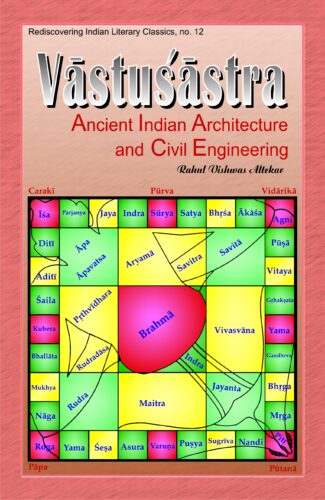-


Vastusastra...
Vastusastra
Ancient Indian Architecture and Civil Engineering Retrospects and Prospests by: Rahul V. AltekarExamining vàstu÷àstra’s conceptual roots in øilpa÷àstra and its later evolution, the volume analyses technical aspects of vàstu÷àstra by concentrating on the essential elements (aïgas) of vàstu÷àstra which involve decision-making and actual construction methods, art of engineering and role and responsibilities of engineers, and aspects related to land materials and rituals associated with use of building after its construction
₹900.00
ISBN: 9788124602461
Year Of Publication: 2010
Edition: 2nd
Pages : xv, 284
Bibliographic Details : 7 Figures, Appendices, Glossary, Index, Bibliography
Language : English
Binding : Hardcover
Publisher: D.K. Printworld Pvt. Ltd.
Size: 23
Weight: 600
Though there has been considerable interest in vastushastra in recent times and the orientational aspects of vastushastra have been often discussed, little is known of the essential elements that constitute This small book, written in a simple and lucid style, contains teachings of great men, gleanings from the scriptures, and examples from the epics and Puranas, and suggests easy solutions to the various problems faced by man in the present-day world of violence, wars, killings and disasters, and how to have a holistic approach to life vastushastra and its scientific application in the present day. Based on extensive research, the work, vastushastra attempts to address this aspect. Examining comprehensively the subject of vastushastra: its conceptual roots in Shilpashastra and its later evolution as dealt with in the Vedas, the Epic literature, Arthashastra, literature on ayurveda and Kamasutra literature, the volume analyses technical aspects of vastushastra by concentrating on the essential elements [angas] of vastushastra which involve decision-making and actual construction methods, art of engineering and role and responsibilities of engineers, and aspects related to land materials and rituals associated with use of building after its construction. It discusses the eco-friendly life style of the ancient Indians based on vastushastra principles. Giving minute attention to details, it focuses on the application of vastushastra in the present-day society — how the vastushastra principles can be scientifically applied and the potential of application of vastushastra keeping in view modern trends in architectural science and civil engineering.
The book will be useful for students and scholars of architecture and engineering and those interested in vastushastra.
Preamble
Abbreviations
Acknowledgements
Part I
Retrospects of Vastushastra
1. Evolution
Introduction
Pre-Vedic Period
Architectural Evidences
Harappan Culture
Recent Developments
Vedic Era
Later Developments
2. Analysis of the Literature on Vastushastra
Survey
Literature in Indian Languages
Brief Account of Tristambha
Research Papers
Objectives
Retrospects of VS
Technical Analysis
Prospects
3. Literary Reflections
VS in Ramayana (RM)
VS in Mahabharata (MHB)
VS in Dharmashastra
VS in Manu-Smriti (MS)
VS in Arthashastra (ARS)
VS in Kamashastra (KS)
VS in Ayurveda (AVD)
Orientations and Lay-Out Considerations
Concept of Ghritagriha
Measurement Systems
Shilpi and Vaidya
Aspects of Bhumi
Astrological Influences
Part II
Technical Analysis
4. Introduction to Ashtanga Vastushastra
Concept of Ashtanga Vastushastra
5. Characteristics of a Host (Yajamana)
Name
Graha Dasha
Kakini Vicara
Preferred Orientation
Compatibility of Yajamana with Village
Mandla Vicara
Horoscope
Determination of Rashi Effects
Determination of Grama Nakshatra Cakra Effect
Door Allocation Test
Preferred Sites for Living
Caste
Selection of the Proper Land
Design Parameters of Home
Design of Shanku and its Sthapana
Profession
Recommendations 1 to 4
Anthropometrics
Test 1
Mandalesha Effect
6. Characteristics of an Engineer (Shilpi)
Sthapati
Sutragrahi
Takshaka
Vardhaki
Karmi
Selection Process of Shilpi
Hierarchies, Accountability and Reporting Structure
Division of Income Between Shilpis
7. Land Selection (Bhumi)
Land Formation
Testing and Selection
Land Testing
Shalya Vicara
Conclusion
8. Rituals (Vastoshpati)
Introduction
Rituals
Method of Grihapravesha
Vastu Pujana
9. Lay-out (Padavinyasa)
Concept of Vastupurushamandala (VPM)
Orientation (Nyasa) of Elements on VPM
General Pattern of Orientation
Allocations of Elements
Concepts and Calculations of Ayadi
Structural Considerations
Concept of Marma of Vastoshpati
Pictorial Overview of Marma Concept
10. Building Materials (Vastu)
Ancient Indian Material Technology
Types of Materials
Classification and Properties of the Material
Avastha of Material
Theory of Material Processing
Study of Building Materials
Brick
Lime
Stone
Wood
Metals
11. Art of Practise of Engineering (Sthapatya)
Philosophical Approach
Metrology, Tooling and Instrumentation
Measurement of Time
Measurement of Space
Mass Measurement
Measurement of Motion
Aspects of Instrumentations
Aspects of Tools
Estimation (Diksadhana)
Design of Merging Elements
Basement
Doors
Walls
Structures (Joints)
Project Management
12. Repairs, Modifications and Interior Decorations (Alankarana)
Repairs and Modifications of Vastu
Rules for the Renovation of Pedestals
Interior and Exteriors
Need and Scope of Interior and Exterior
Wall Painting
Bed Design
Gardening
Well Construction
Part III
The Prospects of vastushastra
13. Scenario Analysis
Introduction
Data Collection and Analysis
Internet Sites and NRC Literature
Academic Institutions
14. Prospective Learning
Technical Aspects
Design Considerations
Considerations for Internal and External Home Environment
Social Aspects
Environmental Aspects
Use of Natural Material for Building Construction
Cultivation of Gardens and Trees
Considerations to the Life Stage of the Wood
Less New Constructions
Orientation Principles
Plumbing, Draining and Waste Disposal
Conservation of Water
Medicinal Plantations
15. Conclusions
Summary
The Concept of AVS
Conclusions, Recommendations and Benefits of Research
Recommendations
Benefits of this Study
Appendix-I: Estimation of One Angula in Millimetres
Appendix-II: SHS References by Vaze
Appendix-III: Questionnaire
Bibliography
Glossary
Index







